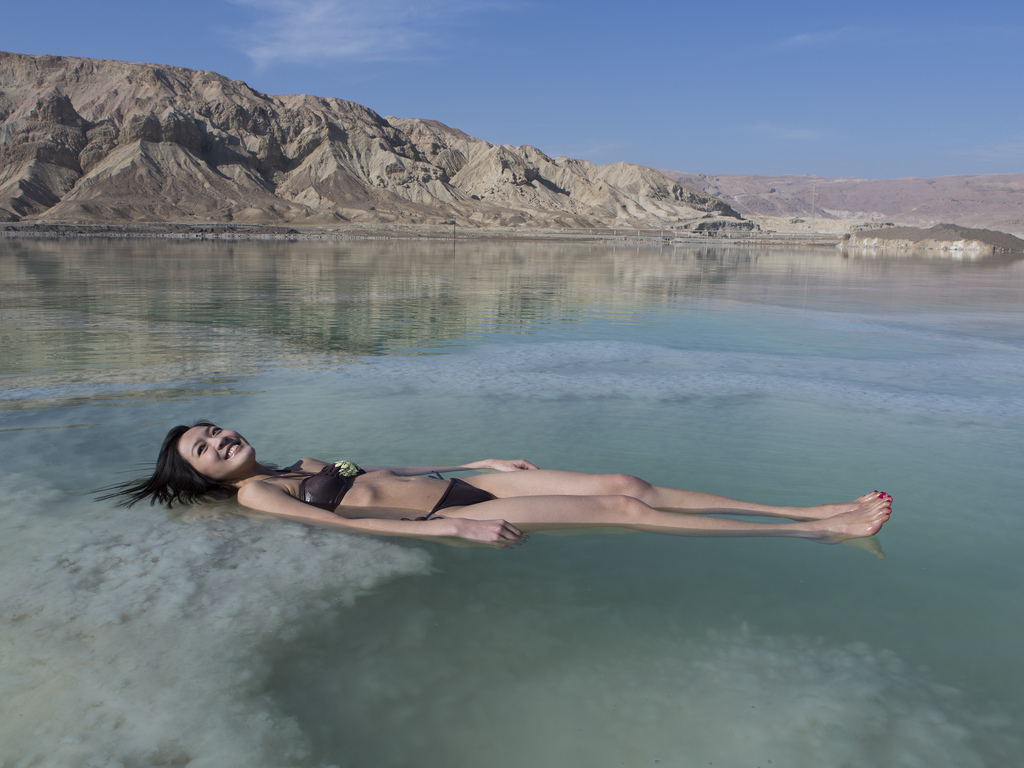
Flick/Itamar Grinberg
Filling a sunken land at the lowest point on earth, the Dead Sea in the Middle East is one of the world’s most fascinating places. It’s an incredible salty lake–one of the world’s saltiest bodies of water, in fact. As a giant solution in which 45 billion tons of salts has been dissolved, it’s about 10 times saltier than ocean water. This is not the kind of salt used to season meals. Although there is some sodium chloride in the mix, most of the salts are mineral deposits ranging from sulfur to bromine and potassium. The lake is so saline, no macroorganisms can live in it–hence its name.
Salt of the Earth
The landlocked body of water, bordering modern-day Israel, Jordan and the West Bank, was called the Eastern Sea before the Romans renamed it ‘Mare Mortuum,’ or Dead Sea. The Greeks called the sea ‘Lake Asphaltites,’ after the mysterious plumes of asphalt that spew up from the lake floor. Today, the Israelis simply call it the Sea of Salt, which is more to the point. Located in the depths of the Great Rift Valley, the Dead Sea is the planet’s lowest-lying land, with a shoreline 1,300 feet below sea level, about a quarter of a mile. It’s another quarter-mile down at its deepest point, making it the world’s deepest hypersaline lake. This prime location and unusual depth give the lake its unique salty composition. The water has absorbed the properties of the deep valley crust in which it lies.
Life-Giving Properties of the Dead Sea
Ironically, the reason it is called the Dead Sea is the same reason it can support human health and longevity. The mineral composition of the Sea has proven healing properties, thanks to high concentrations of essential mineral salts like magnesium, potassium and calcium. Its elemental waters are known to assuage diseases of inflammation, skin disease, arthritis, rheumatism, asthma, psoriasis and cystic fibrosis. Humans have sought the balneotherapeutic salve of its waters for thousands of years. According to legend, it was once a beauty retreat for Cleopatra. Today, the Dead Sea is a global hub for tourism, health research and commercial mineral extraction. The northern shores of the ‘world’s largest natural spa’ are lined with resorts, hot springs and health research facilities, all trying to get a piece of this wonder of nature.
Death of the Dead Sea
The Dead Sea might finally live up to its name by 2050, scientists say. Four decades ago, the water level was 80 feet higher than it is today. Now it’s losing a meter of depth with each passing year. At current rates of exploitation, we can expect its holy waters to dry up in a few decades. Because the landlocked Dead Sea is a terminal body of water, the only way that water can escape is by evaporation. As water evaporates from its surface, the lake is naturally resupplied by the Jordan River. But with 90 percent of those headwaters now being diverted to sustain large human populations, the lake is evaporating faster than it can be replenished.
Bonus Facts To Arouse Your Curiosity
- Swimming in the Dead Sea is quite difficult because the water is so full of salt, it’s denser than the human body. As a result, most visitors just float on their backs. The waters provide a feeling of weightlessness, so you don’t have to work very hard to stay above water.
- It is a popular yet dangerous myth that you cannot drown in the Dead Sea. You definitely can, and many people have, despite the natural buoyancy effects. Actually, if you do accidentally swallow the water, its salinity will quickly defeat the body’s internal balance of electrolytes, causing it to shut down quicker than expected. The Dead Sea is considered the second most dangerous body of water in Israel.
- At the Dead Sea, the weather is always warm and balmy, yet the waters are strikingly empty. No one fishes here, and there are no coral reefs, nor sharks cruising for prey. But the Dead Sea is not really dead. It is rather the exclusive home of a host of unique, largely invisible microorganisms. Many types of thermophilic bacteria and fungi thrive here.